How Schools Can Involve Stakeholders in Reducing Bullying Research 2022
VerifiedAdded on 2022/11/21
|10
|3158
|15
AI Summary
Contribute Materials
Your contribution can guide someone’s learning journey. Share your
documents today.
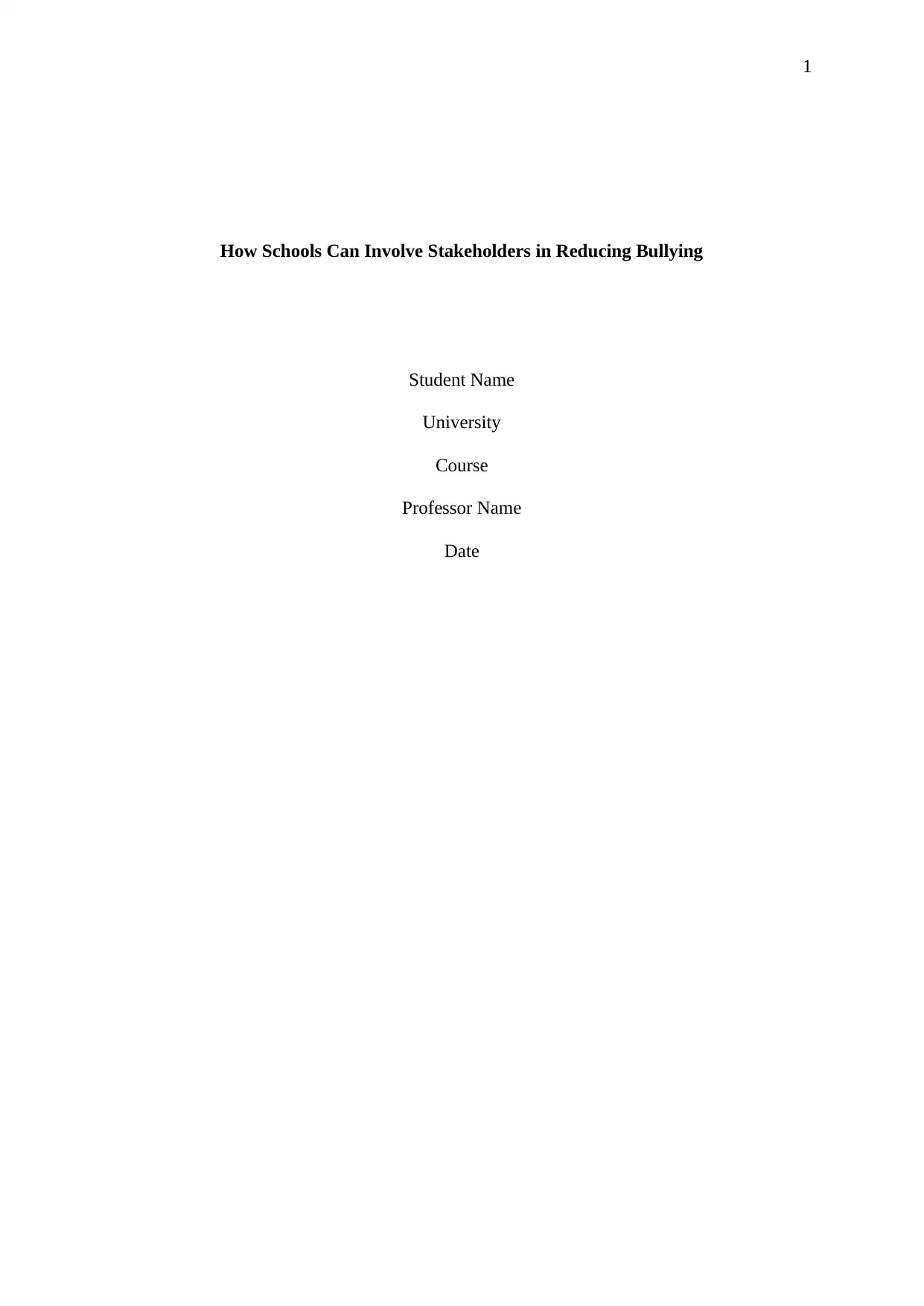
1
How Schools Can Involve Stakeholders in Reducing Bullying
Student Name
University
Course
Professor Name
Date
How Schools Can Involve Stakeholders in Reducing Bullying
Student Name
University
Course
Professor Name
Date
Secure Best Marks with AI Grader
Need help grading? Try our AI Grader for instant feedback on your assignments.
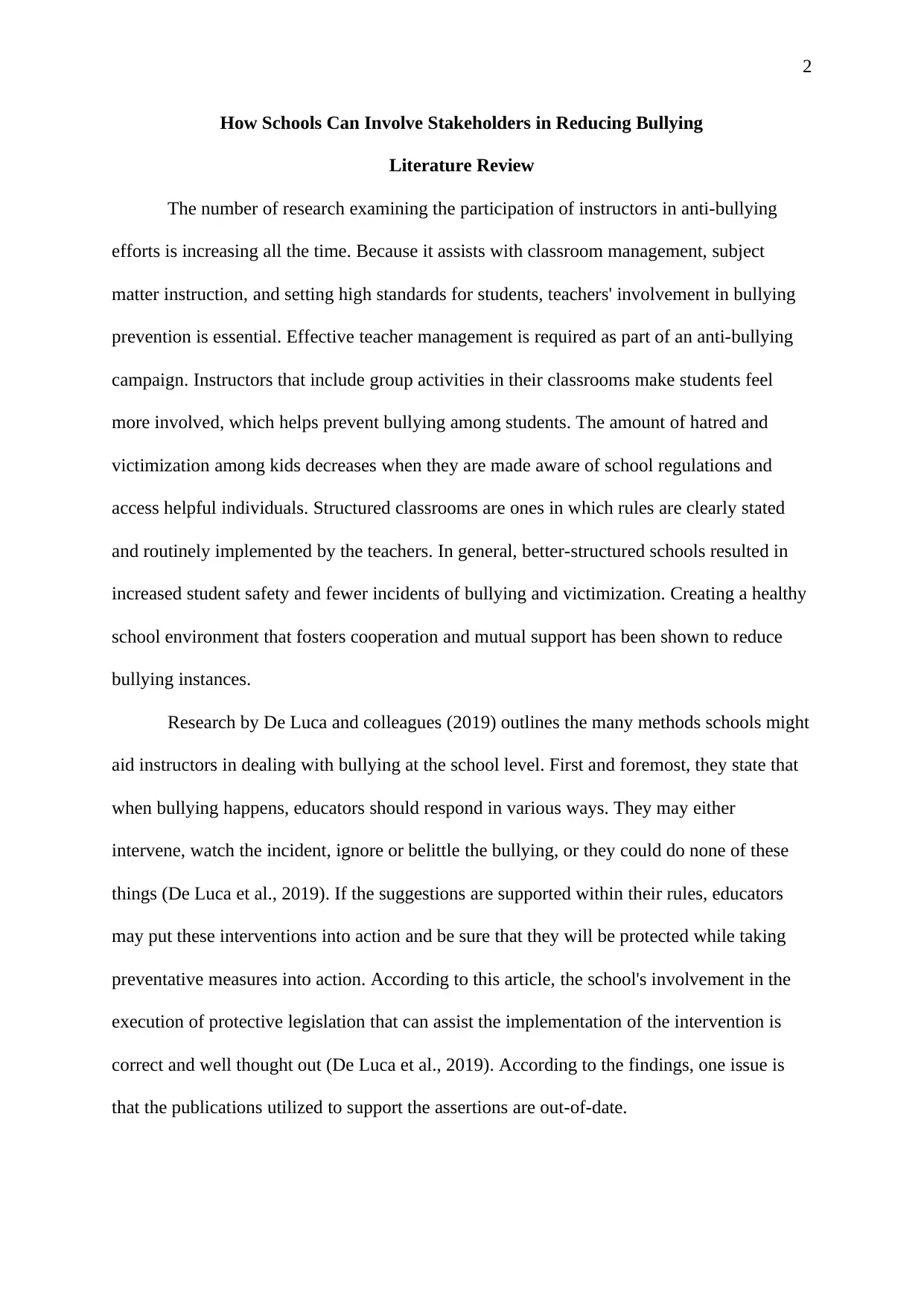
2
How Schools Can Involve Stakeholders in Reducing Bullying
Literature Review
The number of research examining the participation of instructors in anti-bullying
efforts is increasing all the time. Because it assists with classroom management, subject
matter instruction, and setting high standards for students, teachers' involvement in bullying
prevention is essential. Effective teacher management is required as part of an anti-bullying
campaign. Instructors that include group activities in their classrooms make students feel
more involved, which helps prevent bullying among students. The amount of hatred and
victimization among kids decreases when they are made aware of school regulations and
access helpful individuals. Structured classrooms are ones in which rules are clearly stated
and routinely implemented by the teachers. In general, better-structured schools resulted in
increased student safety and fewer incidents of bullying and victimization. Creating a healthy
school environment that fosters cooperation and mutual support has been shown to reduce
bullying instances.
Research by De Luca and colleagues (2019) outlines the many methods schools might
aid instructors in dealing with bullying at the school level. First and foremost, they state that
when bullying happens, educators should respond in various ways. They may either
intervene, watch the incident, ignore or belittle the bullying, or they could do none of these
things (De Luca et al., 2019). If the suggestions are supported within their rules, educators
may put these interventions into action and be sure that they will be protected while taking
preventative measures into action. According to this article, the school's involvement in the
execution of protective legislation that can assist the implementation of the intervention is
correct and well thought out (De Luca et al., 2019). According to the findings, one issue is
that the publications utilized to support the assertions are out-of-date.
How Schools Can Involve Stakeholders in Reducing Bullying
Literature Review
The number of research examining the participation of instructors in anti-bullying
efforts is increasing all the time. Because it assists with classroom management, subject
matter instruction, and setting high standards for students, teachers' involvement in bullying
prevention is essential. Effective teacher management is required as part of an anti-bullying
campaign. Instructors that include group activities in their classrooms make students feel
more involved, which helps prevent bullying among students. The amount of hatred and
victimization among kids decreases when they are made aware of school regulations and
access helpful individuals. Structured classrooms are ones in which rules are clearly stated
and routinely implemented by the teachers. In general, better-structured schools resulted in
increased student safety and fewer incidents of bullying and victimization. Creating a healthy
school environment that fosters cooperation and mutual support has been shown to reduce
bullying instances.
Research by De Luca and colleagues (2019) outlines the many methods schools might
aid instructors in dealing with bullying at the school level. First and foremost, they state that
when bullying happens, educators should respond in various ways. They may either
intervene, watch the incident, ignore or belittle the bullying, or they could do none of these
things (De Luca et al., 2019). If the suggestions are supported within their rules, educators
may put these interventions into action and be sure that they will be protected while taking
preventative measures into action. According to this article, the school's involvement in the
execution of protective legislation that can assist the implementation of the intervention is
correct and well thought out (De Luca et al., 2019). According to the findings, one issue is
that the publications utilized to support the assertions are out-of-date.
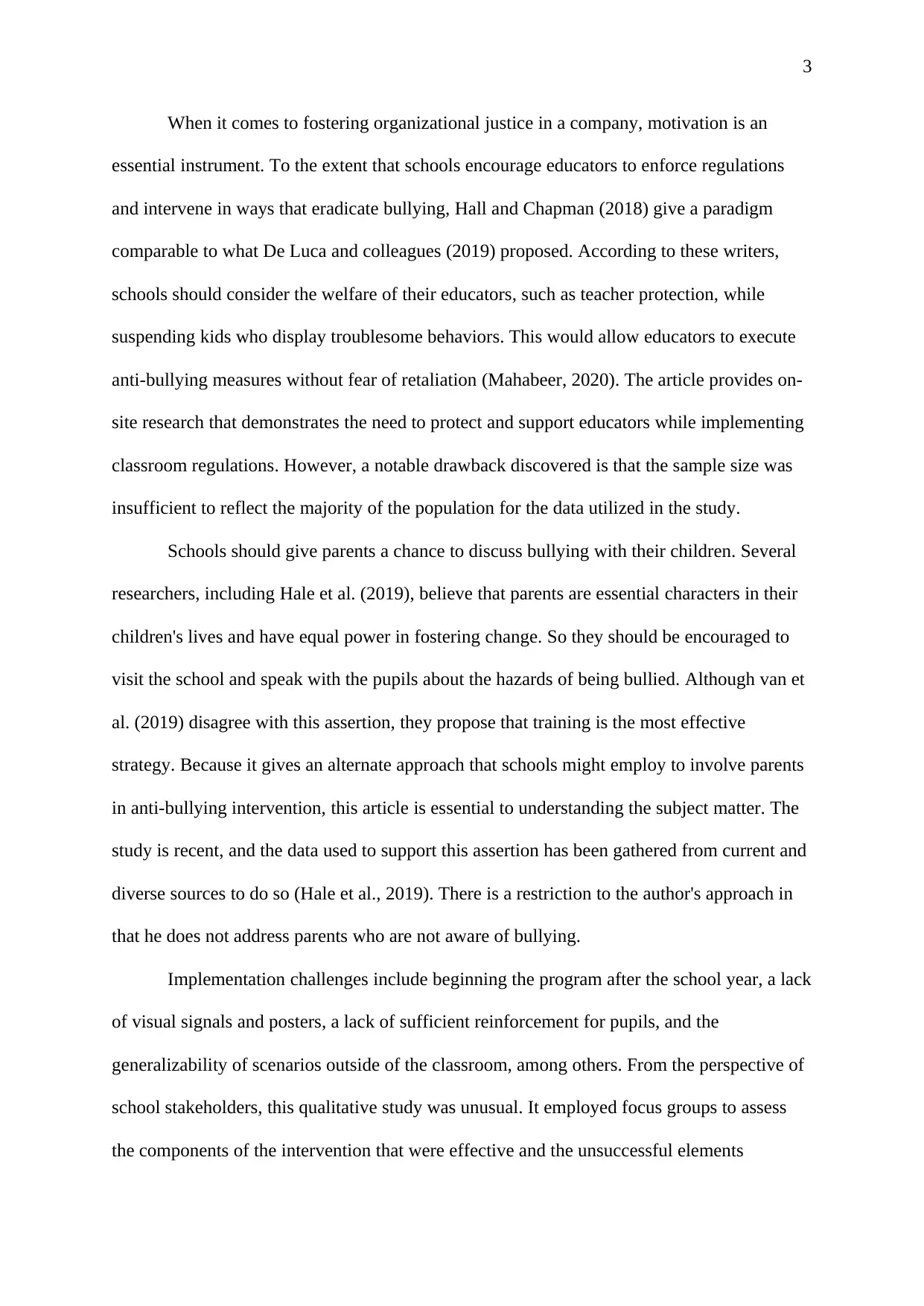
3
When it comes to fostering organizational justice in a company, motivation is an
essential instrument. To the extent that schools encourage educators to enforce regulations
and intervene in ways that eradicate bullying, Hall and Chapman (2018) give a paradigm
comparable to what De Luca and colleagues (2019) proposed. According to these writers,
schools should consider the welfare of their educators, such as teacher protection, while
suspending kids who display troublesome behaviors. This would allow educators to execute
anti-bullying measures without fear of retaliation (Mahabeer, 2020). The article provides on-
site research that demonstrates the need to protect and support educators while implementing
classroom regulations. However, a notable drawback discovered is that the sample size was
insufficient to reflect the majority of the population for the data utilized in the study.
Schools should give parents a chance to discuss bullying with their children. Several
researchers, including Hale et al. (2019), believe that parents are essential characters in their
children's lives and have equal power in fostering change. So they should be encouraged to
visit the school and speak with the pupils about the hazards of being bullied. Although van et
al. (2019) disagree with this assertion, they propose that training is the most effective
strategy. Because it gives an alternate approach that schools might employ to involve parents
in anti-bullying intervention, this article is essential to understanding the subject matter. The
study is recent, and the data used to support this assertion has been gathered from current and
diverse sources to do so (Hale et al., 2019). There is a restriction to the author's approach in
that he does not address parents who are not aware of bullying.
Implementation challenges include beginning the program after the school year, a lack
of visual signals and posters, a lack of sufficient reinforcement for pupils, and the
generalizability of scenarios outside of the classroom, among others. From the perspective of
school stakeholders, this qualitative study was unusual. It employed focus groups to assess
the components of the intervention that were effective and the unsuccessful elements
When it comes to fostering organizational justice in a company, motivation is an
essential instrument. To the extent that schools encourage educators to enforce regulations
and intervene in ways that eradicate bullying, Hall and Chapman (2018) give a paradigm
comparable to what De Luca and colleagues (2019) proposed. According to these writers,
schools should consider the welfare of their educators, such as teacher protection, while
suspending kids who display troublesome behaviors. This would allow educators to execute
anti-bullying measures without fear of retaliation (Mahabeer, 2020). The article provides on-
site research that demonstrates the need to protect and support educators while implementing
classroom regulations. However, a notable drawback discovered is that the sample size was
insufficient to reflect the majority of the population for the data utilized in the study.
Schools should give parents a chance to discuss bullying with their children. Several
researchers, including Hale et al. (2019), believe that parents are essential characters in their
children's lives and have equal power in fostering change. So they should be encouraged to
visit the school and speak with the pupils about the hazards of being bullied. Although van et
al. (2019) disagree with this assertion, they propose that training is the most effective
strategy. Because it gives an alternate approach that schools might employ to involve parents
in anti-bullying intervention, this article is essential to understanding the subject matter. The
study is recent, and the data used to support this assertion has been gathered from current and
diverse sources to do so (Hale et al., 2019). There is a restriction to the author's approach in
that he does not address parents who are not aware of bullying.
Implementation challenges include beginning the program after the school year, a lack
of visual signals and posters, a lack of sufficient reinforcement for pupils, and the
generalizability of scenarios outside of the classroom, among others. From the perspective of
school stakeholders, this qualitative study was unusual. It employed focus groups to assess
the components of the intervention that were effective and the unsuccessful elements
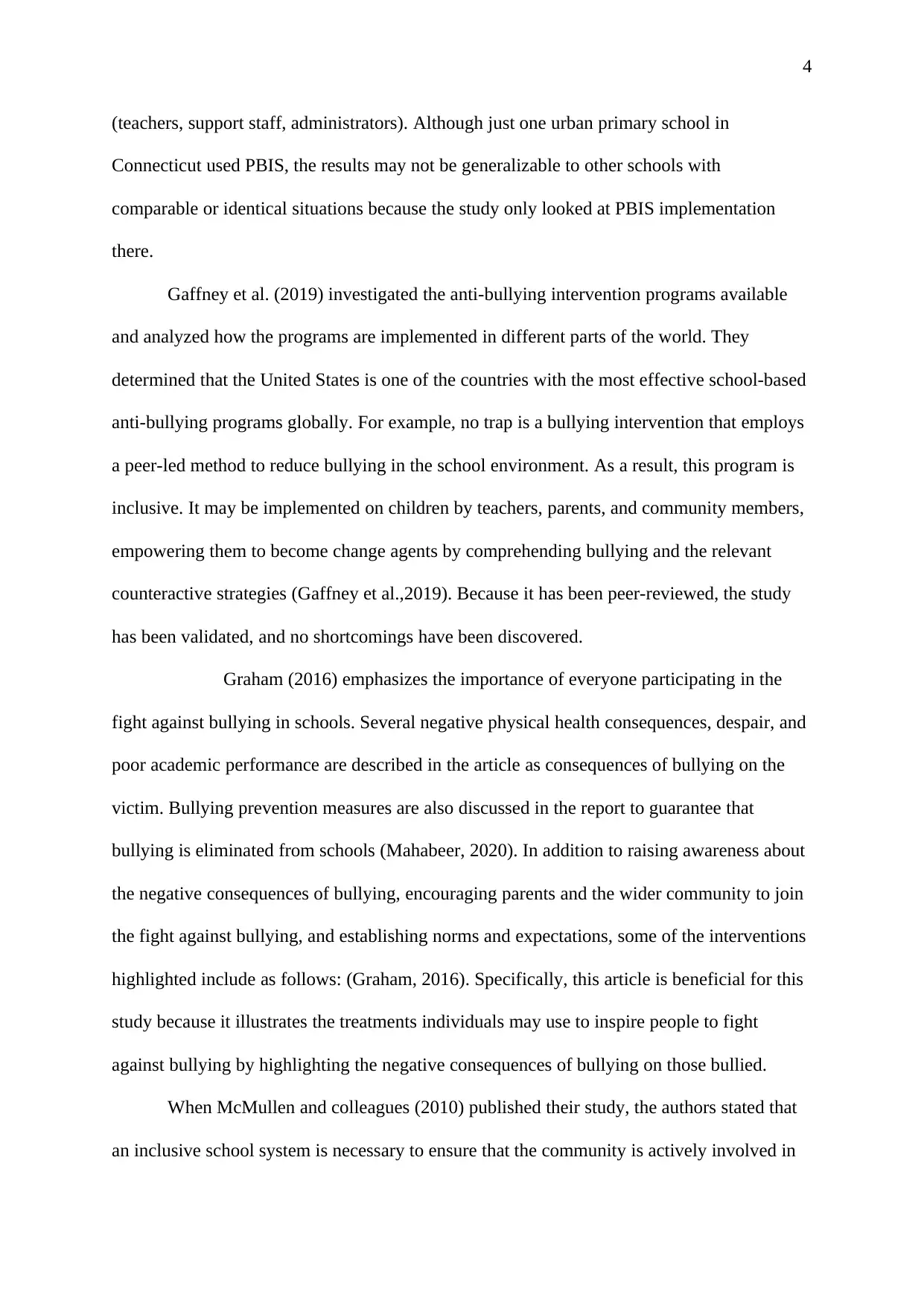
4
(teachers, support staff, administrators). Although just one urban primary school in
Connecticut used PBIS, the results may not be generalizable to other schools with
comparable or identical situations because the study only looked at PBIS implementation
there.
Gaffney et al. (2019) investigated the anti-bullying intervention programs available
and analyzed how the programs are implemented in different parts of the world. They
determined that the United States is one of the countries with the most effective school-based
anti-bullying programs globally. For example, no trap is a bullying intervention that employs
a peer-led method to reduce bullying in the school environment. As a result, this program is
inclusive. It may be implemented on children by teachers, parents, and community members,
empowering them to become change agents by comprehending bullying and the relevant
counteractive strategies (Gaffney et al.,2019). Because it has been peer-reviewed, the study
has been validated, and no shortcomings have been discovered.
Graham (2016) emphasizes the importance of everyone participating in the
fight against bullying in schools. Several negative physical health consequences, despair, and
poor academic performance are described in the article as consequences of bullying on the
victim. Bullying prevention measures are also discussed in the report to guarantee that
bullying is eliminated from schools (Mahabeer, 2020). In addition to raising awareness about
the negative consequences of bullying, encouraging parents and the wider community to join
the fight against bullying, and establishing norms and expectations, some of the interventions
highlighted include as follows: (Graham, 2016). Specifically, this article is beneficial for this
study because it illustrates the treatments individuals may use to inspire people to fight
against bullying by highlighting the negative consequences of bullying on those bullied.
When McMullen and colleagues (2010) published their study, the authors stated that
an inclusive school system is necessary to ensure that the community is actively involved in
(teachers, support staff, administrators). Although just one urban primary school in
Connecticut used PBIS, the results may not be generalizable to other schools with
comparable or identical situations because the study only looked at PBIS implementation
there.
Gaffney et al. (2019) investigated the anti-bullying intervention programs available
and analyzed how the programs are implemented in different parts of the world. They
determined that the United States is one of the countries with the most effective school-based
anti-bullying programs globally. For example, no trap is a bullying intervention that employs
a peer-led method to reduce bullying in the school environment. As a result, this program is
inclusive. It may be implemented on children by teachers, parents, and community members,
empowering them to become change agents by comprehending bullying and the relevant
counteractive strategies (Gaffney et al.,2019). Because it has been peer-reviewed, the study
has been validated, and no shortcomings have been discovered.
Graham (2016) emphasizes the importance of everyone participating in the
fight against bullying in schools. Several negative physical health consequences, despair, and
poor academic performance are described in the article as consequences of bullying on the
victim. Bullying prevention measures are also discussed in the report to guarantee that
bullying is eliminated from schools (Mahabeer, 2020). In addition to raising awareness about
the negative consequences of bullying, encouraging parents and the wider community to join
the fight against bullying, and establishing norms and expectations, some of the interventions
highlighted include as follows: (Graham, 2016). Specifically, this article is beneficial for this
study because it illustrates the treatments individuals may use to inspire people to fight
against bullying by highlighting the negative consequences of bullying on those bullied.
When McMullen and colleagues (2010) published their study, the authors stated that
an inclusive school system is necessary to ensure that the community is actively involved in
Secure Best Marks with AI Grader
Need help grading? Try our AI Grader for instant feedback on your assignments.
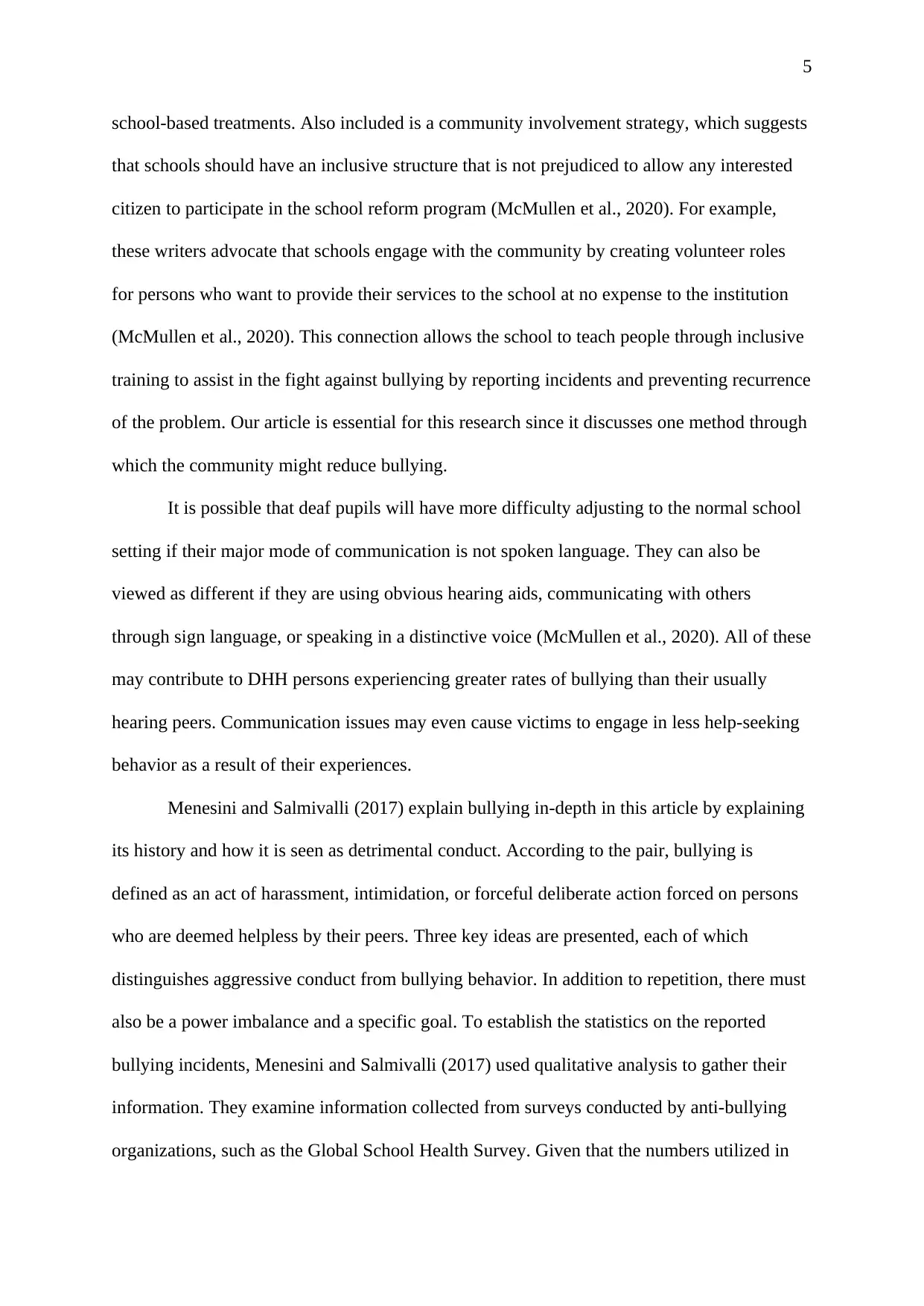
5
school-based treatments. Also included is a community involvement strategy, which suggests
that schools should have an inclusive structure that is not prejudiced to allow any interested
citizen to participate in the school reform program (McMullen et al., 2020). For example,
these writers advocate that schools engage with the community by creating volunteer roles
for persons who want to provide their services to the school at no expense to the institution
(McMullen et al., 2020). This connection allows the school to teach people through inclusive
training to assist in the fight against bullying by reporting incidents and preventing recurrence
of the problem. Our article is essential for this research since it discusses one method through
which the community might reduce bullying.
It is possible that deaf pupils will have more difficulty adjusting to the normal school
setting if their major mode of communication is not spoken language. They can also be
viewed as different if they are using obvious hearing aids, communicating with others
through sign language, or speaking in a distinctive voice (McMullen et al., 2020). All of these
may contribute to DHH persons experiencing greater rates of bullying than their usually
hearing peers. Communication issues may even cause victims to engage in less help-seeking
behavior as a result of their experiences.
Menesini and Salmivalli (2017) explain bullying in-depth in this article by explaining
its history and how it is seen as detrimental conduct. According to the pair, bullying is
defined as an act of harassment, intimidation, or forceful deliberate action forced on persons
who are deemed helpless by their peers. Three key ideas are presented, each of which
distinguishes aggressive conduct from bullying behavior. In addition to repetition, there must
also be a power imbalance and a specific goal. To establish the statistics on the reported
bullying incidents, Menesini and Salmivalli (2017) used qualitative analysis to gather their
information. They examine information collected from surveys conducted by anti-bullying
organizations, such as the Global School Health Survey. Given that the numbers utilized in
school-based treatments. Also included is a community involvement strategy, which suggests
that schools should have an inclusive structure that is not prejudiced to allow any interested
citizen to participate in the school reform program (McMullen et al., 2020). For example,
these writers advocate that schools engage with the community by creating volunteer roles
for persons who want to provide their services to the school at no expense to the institution
(McMullen et al., 2020). This connection allows the school to teach people through inclusive
training to assist in the fight against bullying by reporting incidents and preventing recurrence
of the problem. Our article is essential for this research since it discusses one method through
which the community might reduce bullying.
It is possible that deaf pupils will have more difficulty adjusting to the normal school
setting if their major mode of communication is not spoken language. They can also be
viewed as different if they are using obvious hearing aids, communicating with others
through sign language, or speaking in a distinctive voice (McMullen et al., 2020). All of these
may contribute to DHH persons experiencing greater rates of bullying than their usually
hearing peers. Communication issues may even cause victims to engage in less help-seeking
behavior as a result of their experiences.
Menesini and Salmivalli (2017) explain bullying in-depth in this article by explaining
its history and how it is seen as detrimental conduct. According to the pair, bullying is
defined as an act of harassment, intimidation, or forceful deliberate action forced on persons
who are deemed helpless by their peers. Three key ideas are presented, each of which
distinguishes aggressive conduct from bullying behavior. In addition to repetition, there must
also be a power imbalance and a specific goal. To establish the statistics on the reported
bullying incidents, Menesini and Salmivalli (2017) used qualitative analysis to gather their
information. They examine information collected from surveys conducted by anti-bullying
organizations, such as the Global School Health Survey. Given that the numbers utilized in
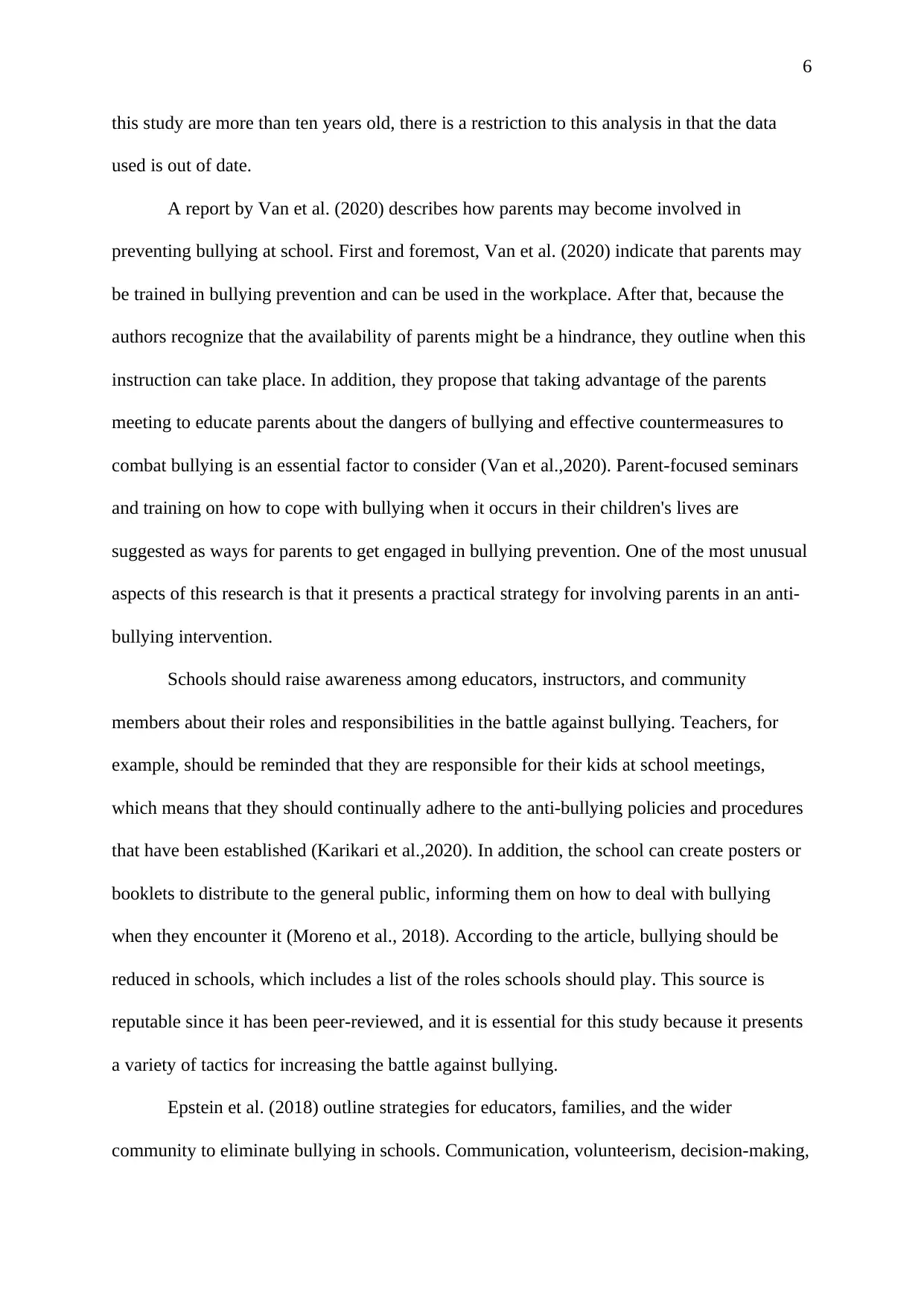
6
this study are more than ten years old, there is a restriction to this analysis in that the data
used is out of date.
A report by Van et al. (2020) describes how parents may become involved in
preventing bullying at school. First and foremost, Van et al. (2020) indicate that parents may
be trained in bullying prevention and can be used in the workplace. After that, because the
authors recognize that the availability of parents might be a hindrance, they outline when this
instruction can take place. In addition, they propose that taking advantage of the parents
meeting to educate parents about the dangers of bullying and effective countermeasures to
combat bullying is an essential factor to consider (Van et al.,2020). Parent-focused seminars
and training on how to cope with bullying when it occurs in their children's lives are
suggested as ways for parents to get engaged in bullying prevention. One of the most unusual
aspects of this research is that it presents a practical strategy for involving parents in an anti-
bullying intervention.
Schools should raise awareness among educators, instructors, and community
members about their roles and responsibilities in the battle against bullying. Teachers, for
example, should be reminded that they are responsible for their kids at school meetings,
which means that they should continually adhere to the anti-bullying policies and procedures
that have been established (Karikari et al.,2020). In addition, the school can create posters or
booklets to distribute to the general public, informing them on how to deal with bullying
when they encounter it (Moreno et al., 2018). According to the article, bullying should be
reduced in schools, which includes a list of the roles schools should play. This source is
reputable since it has been peer-reviewed, and it is essential for this study because it presents
a variety of tactics for increasing the battle against bullying.
Epstein et al. (2018) outline strategies for educators, families, and the wider
community to eliminate bullying in schools. Communication, volunteerism, decision-making,
this study are more than ten years old, there is a restriction to this analysis in that the data
used is out of date.
A report by Van et al. (2020) describes how parents may become involved in
preventing bullying at school. First and foremost, Van et al. (2020) indicate that parents may
be trained in bullying prevention and can be used in the workplace. After that, because the
authors recognize that the availability of parents might be a hindrance, they outline when this
instruction can take place. In addition, they propose that taking advantage of the parents
meeting to educate parents about the dangers of bullying and effective countermeasures to
combat bullying is an essential factor to consider (Van et al.,2020). Parent-focused seminars
and training on how to cope with bullying when it occurs in their children's lives are
suggested as ways for parents to get engaged in bullying prevention. One of the most unusual
aspects of this research is that it presents a practical strategy for involving parents in an anti-
bullying intervention.
Schools should raise awareness among educators, instructors, and community
members about their roles and responsibilities in the battle against bullying. Teachers, for
example, should be reminded that they are responsible for their kids at school meetings,
which means that they should continually adhere to the anti-bullying policies and procedures
that have been established (Karikari et al.,2020). In addition, the school can create posters or
booklets to distribute to the general public, informing them on how to deal with bullying
when they encounter it (Moreno et al., 2018). According to the article, bullying should be
reduced in schools, which includes a list of the roles schools should play. This source is
reputable since it has been peer-reviewed, and it is essential for this study because it presents
a variety of tactics for increasing the battle against bullying.
Epstein et al. (2018) outline strategies for educators, families, and the wider
community to eliminate bullying in schools. Communication, volunteerism, decision-making,
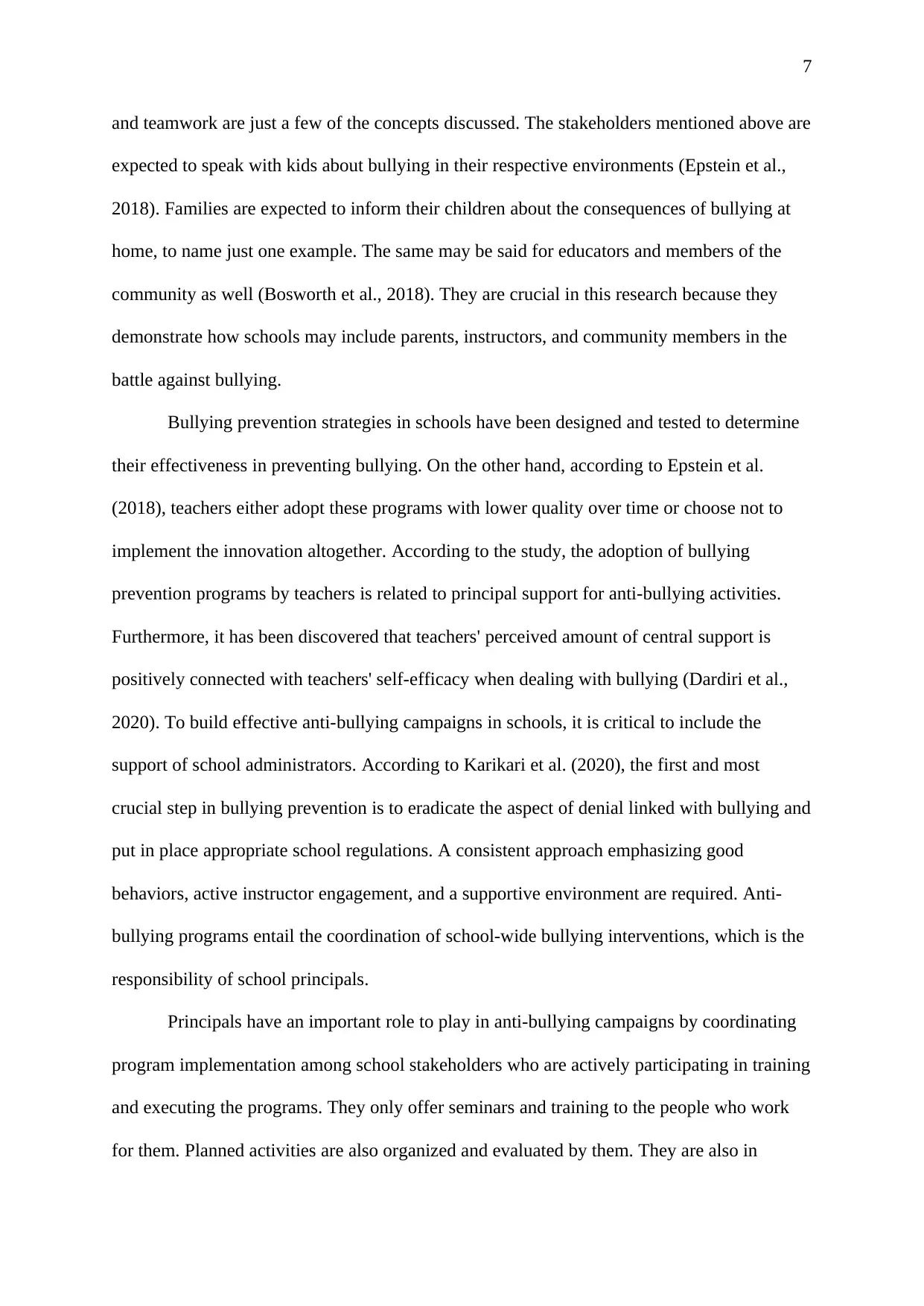
7
and teamwork are just a few of the concepts discussed. The stakeholders mentioned above are
expected to speak with kids about bullying in their respective environments (Epstein et al.,
2018). Families are expected to inform their children about the consequences of bullying at
home, to name just one example. The same may be said for educators and members of the
community as well (Bosworth et al., 2018). They are crucial in this research because they
demonstrate how schools may include parents, instructors, and community members in the
battle against bullying.
Bullying prevention strategies in schools have been designed and tested to determine
their effectiveness in preventing bullying. On the other hand, according to Epstein et al.
(2018), teachers either adopt these programs with lower quality over time or choose not to
implement the innovation altogether. According to the study, the adoption of bullying
prevention programs by teachers is related to principal support for anti-bullying activities.
Furthermore, it has been discovered that teachers' perceived amount of central support is
positively connected with teachers' self-efficacy when dealing with bullying (Dardiri et al.,
2020). To build effective anti-bullying campaigns in schools, it is critical to include the
support of school administrators. According to Karikari et al. (2020), the first and most
crucial step in bullying prevention is to eradicate the aspect of denial linked with bullying and
put in place appropriate school regulations. A consistent approach emphasizing good
behaviors, active instructor engagement, and a supportive environment are required. Anti-
bullying programs entail the coordination of school-wide bullying interventions, which is the
responsibility of school principals.
Principals have an important role to play in anti-bullying campaigns by coordinating
program implementation among school stakeholders who are actively participating in training
and executing the programs. They only offer seminars and training to the people who work
for them. Planned activities are also organized and evaluated by them. They are also in
and teamwork are just a few of the concepts discussed. The stakeholders mentioned above are
expected to speak with kids about bullying in their respective environments (Epstein et al.,
2018). Families are expected to inform their children about the consequences of bullying at
home, to name just one example. The same may be said for educators and members of the
community as well (Bosworth et al., 2018). They are crucial in this research because they
demonstrate how schools may include parents, instructors, and community members in the
battle against bullying.
Bullying prevention strategies in schools have been designed and tested to determine
their effectiveness in preventing bullying. On the other hand, according to Epstein et al.
(2018), teachers either adopt these programs with lower quality over time or choose not to
implement the innovation altogether. According to the study, the adoption of bullying
prevention programs by teachers is related to principal support for anti-bullying activities.
Furthermore, it has been discovered that teachers' perceived amount of central support is
positively connected with teachers' self-efficacy when dealing with bullying (Dardiri et al.,
2020). To build effective anti-bullying campaigns in schools, it is critical to include the
support of school administrators. According to Karikari et al. (2020), the first and most
crucial step in bullying prevention is to eradicate the aspect of denial linked with bullying and
put in place appropriate school regulations. A consistent approach emphasizing good
behaviors, active instructor engagement, and a supportive environment are required. Anti-
bullying programs entail the coordination of school-wide bullying interventions, which is the
responsibility of school principals.
Principals have an important role to play in anti-bullying campaigns by coordinating
program implementation among school stakeholders who are actively participating in training
and executing the programs. They only offer seminars and training to the people who work
for them. Planned activities are also organized and evaluated by them. They are also in
Paraphrase This Document
Need a fresh take? Get an instant paraphrase of this document with our AI Paraphraser
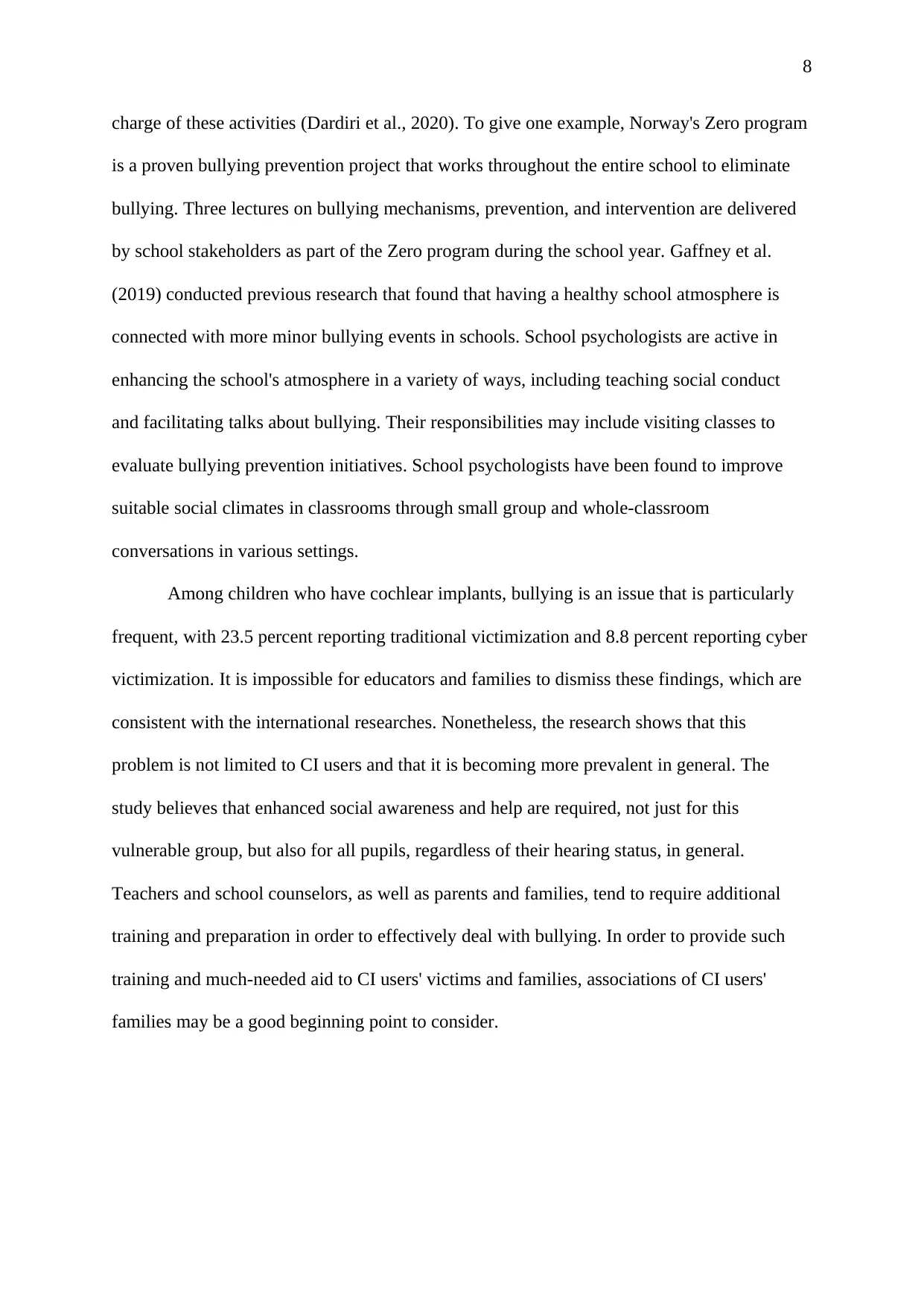
8
charge of these activities (Dardiri et al., 2020). To give one example, Norway's Zero program
is a proven bullying prevention project that works throughout the entire school to eliminate
bullying. Three lectures on bullying mechanisms, prevention, and intervention are delivered
by school stakeholders as part of the Zero program during the school year. Gaffney et al.
(2019) conducted previous research that found that having a healthy school atmosphere is
connected with more minor bullying events in schools. School psychologists are active in
enhancing the school's atmosphere in a variety of ways, including teaching social conduct
and facilitating talks about bullying. Their responsibilities may include visiting classes to
evaluate bullying prevention initiatives. School psychologists have been found to improve
suitable social climates in classrooms through small group and whole-classroom
conversations in various settings.
Among children who have cochlear implants, bullying is an issue that is particularly
frequent, with 23.5 percent reporting traditional victimization and 8.8 percent reporting cyber
victimization. It is impossible for educators and families to dismiss these findings, which are
consistent with the international researches. Nonetheless, the research shows that this
problem is not limited to CI users and that it is becoming more prevalent in general. The
study believes that enhanced social awareness and help are required, not just for this
vulnerable group, but also for all pupils, regardless of their hearing status, in general.
Teachers and school counselors, as well as parents and families, tend to require additional
training and preparation in order to effectively deal with bullying. In order to provide such
training and much-needed aid to CI users' victims and families, associations of CI users'
families may be a good beginning point to consider.
charge of these activities (Dardiri et al., 2020). To give one example, Norway's Zero program
is a proven bullying prevention project that works throughout the entire school to eliminate
bullying. Three lectures on bullying mechanisms, prevention, and intervention are delivered
by school stakeholders as part of the Zero program during the school year. Gaffney et al.
(2019) conducted previous research that found that having a healthy school atmosphere is
connected with more minor bullying events in schools. School psychologists are active in
enhancing the school's atmosphere in a variety of ways, including teaching social conduct
and facilitating talks about bullying. Their responsibilities may include visiting classes to
evaluate bullying prevention initiatives. School psychologists have been found to improve
suitable social climates in classrooms through small group and whole-classroom
conversations in various settings.
Among children who have cochlear implants, bullying is an issue that is particularly
frequent, with 23.5 percent reporting traditional victimization and 8.8 percent reporting cyber
victimization. It is impossible for educators and families to dismiss these findings, which are
consistent with the international researches. Nonetheless, the research shows that this
problem is not limited to CI users and that it is becoming more prevalent in general. The
study believes that enhanced social awareness and help are required, not just for this
vulnerable group, but also for all pupils, regardless of their hearing status, in general.
Teachers and school counselors, as well as parents and families, tend to require additional
training and preparation in order to effectively deal with bullying. In order to provide such
training and much-needed aid to CI users' victims and families, associations of CI users'
families may be a good beginning point to consider.
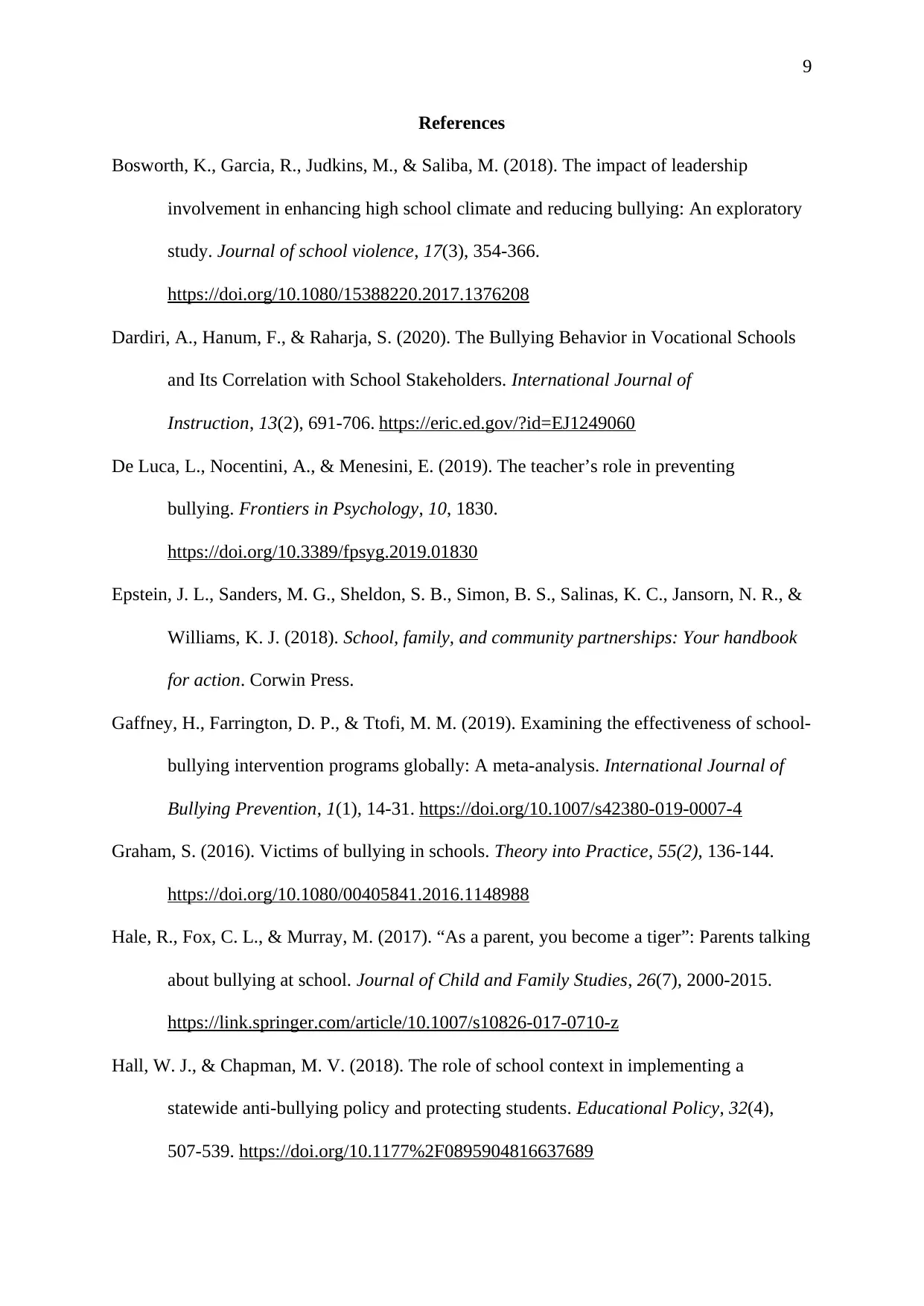
9
References
Bosworth, K., Garcia, R., Judkins, M., & Saliba, M. (2018). The impact of leadership
involvement in enhancing high school climate and reducing bullying: An exploratory
study. Journal of school violence, 17(3), 354-366.
https://doi.org/10.1080/15388220.2017.1376208
Dardiri, A., Hanum, F., & Raharja, S. (2020). The Bullying Behavior in Vocational Schools
and Its Correlation with School Stakeholders. International Journal of
Instruction, 13(2), 691-706. https://eric.ed.gov/?id=EJ1249060
De Luca, L., Nocentini, A., & Menesini, E. (2019). The teacher’s role in preventing
bullying. Frontiers in Psychology, 10, 1830.
https://doi.org/10.3389/fpsyg.2019.01830
Epstein, J. L., Sanders, M. G., Sheldon, S. B., Simon, B. S., Salinas, K. C., Jansorn, N. R., &
Williams, K. J. (2018). School, family, and community partnerships: Your handbook
for action. Corwin Press.
Gaffney, H., Farrington, D. P., & Ttofi, M. M. (2019). Examining the effectiveness of school-
bullying intervention programs globally: A meta-analysis. International Journal of
Bullying Prevention, 1(1), 14-31. https://doi.org/10.1007/s42380-019-0007-4
Graham, S. (2016). Victims of bullying in schools. Theory into Practice, 55(2), 136-144.
https://doi.org/10.1080/00405841.2016.1148988
Hale, R., Fox, C. L., & Murray, M. (2017). “As a parent, you become a tiger”: Parents talking
about bullying at school. Journal of Child and Family Studies, 26(7), 2000-2015.
https://link.springer.com/article/10.1007/s10826-017-0710-z
Hall, W. J., & Chapman, M. V. (2018). The role of school context in implementing a
statewide anti-bullying policy and protecting students. Educational Policy, 32(4),
507-539. https://doi.org/10.1177%2F0895904816637689
References
Bosworth, K., Garcia, R., Judkins, M., & Saliba, M. (2018). The impact of leadership
involvement in enhancing high school climate and reducing bullying: An exploratory
study. Journal of school violence, 17(3), 354-366.
https://doi.org/10.1080/15388220.2017.1376208
Dardiri, A., Hanum, F., & Raharja, S. (2020). The Bullying Behavior in Vocational Schools
and Its Correlation with School Stakeholders. International Journal of
Instruction, 13(2), 691-706. https://eric.ed.gov/?id=EJ1249060
De Luca, L., Nocentini, A., & Menesini, E. (2019). The teacher’s role in preventing
bullying. Frontiers in Psychology, 10, 1830.
https://doi.org/10.3389/fpsyg.2019.01830
Epstein, J. L., Sanders, M. G., Sheldon, S. B., Simon, B. S., Salinas, K. C., Jansorn, N. R., &
Williams, K. J. (2018). School, family, and community partnerships: Your handbook
for action. Corwin Press.
Gaffney, H., Farrington, D. P., & Ttofi, M. M. (2019). Examining the effectiveness of school-
bullying intervention programs globally: A meta-analysis. International Journal of
Bullying Prevention, 1(1), 14-31. https://doi.org/10.1007/s42380-019-0007-4
Graham, S. (2016). Victims of bullying in schools. Theory into Practice, 55(2), 136-144.
https://doi.org/10.1080/00405841.2016.1148988
Hale, R., Fox, C. L., & Murray, M. (2017). “As a parent, you become a tiger”: Parents talking
about bullying at school. Journal of Child and Family Studies, 26(7), 2000-2015.
https://link.springer.com/article/10.1007/s10826-017-0710-z
Hall, W. J., & Chapman, M. V. (2018). The role of school context in implementing a
statewide anti-bullying policy and protecting students. Educational Policy, 32(4),
507-539. https://doi.org/10.1177%2F0895904816637689
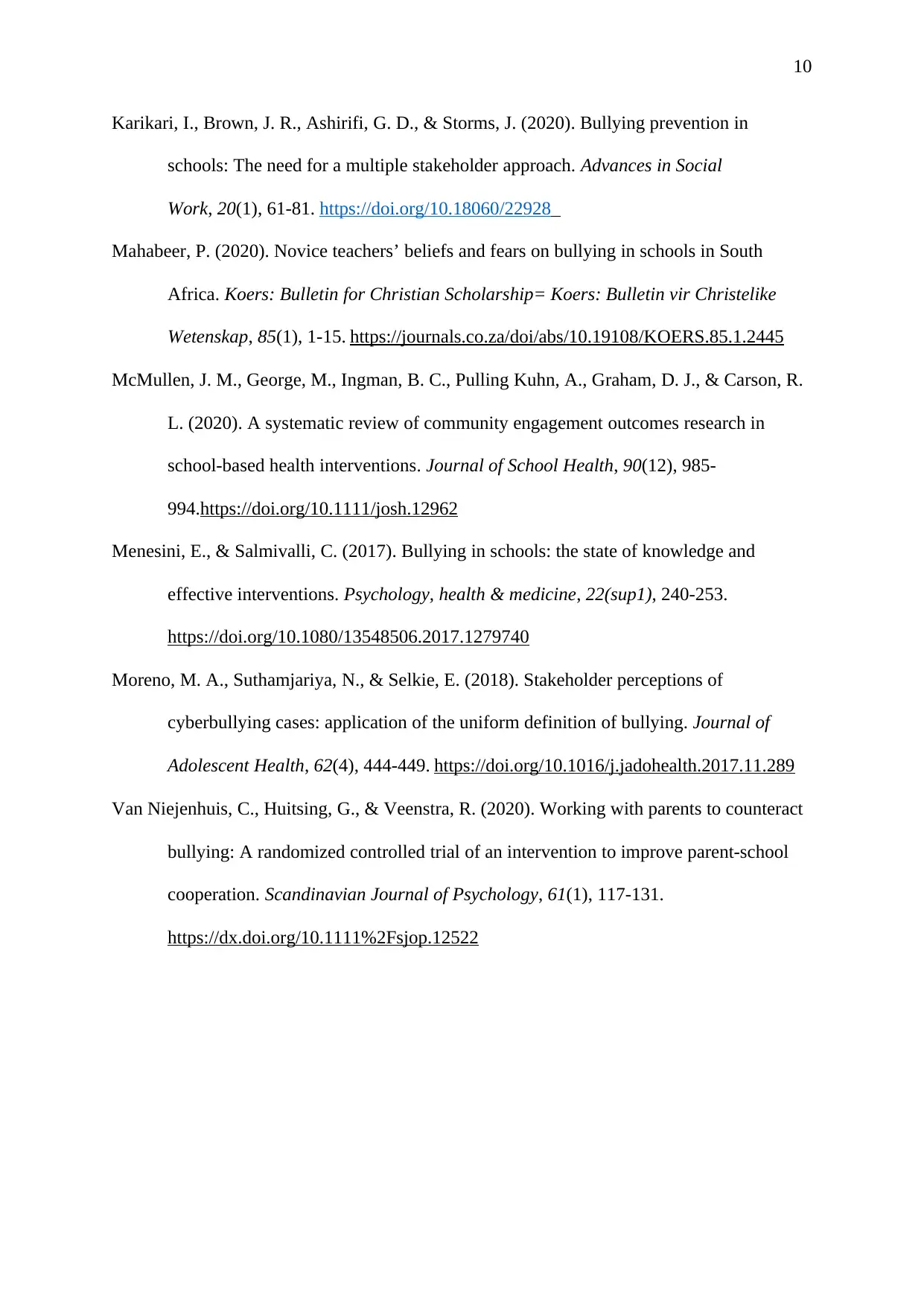
10
Karikari, I., Brown, J. R., Ashirifi, G. D., & Storms, J. (2020). Bullying prevention in
schools: The need for a multiple stakeholder approach. Advances in Social
Work, 20(1), 61-81. https://doi.org/10.18060/22928
Mahabeer, P. (2020). Novice teachers’ beliefs and fears on bullying in schools in South
Africa. Koers: Bulletin for Christian Scholarship= Koers: Bulletin vir Christelike
Wetenskap, 85(1), 1-15. https://journals.co.za/doi/abs/10.19108/KOERS.85.1.2445
McMullen, J. M., George, M., Ingman, B. C., Pulling Kuhn, A., Graham, D. J., & Carson, R.
L. (2020). A systematic review of community engagement outcomes research in
school‐based health interventions. Journal of School Health, 90(12), 985-
994.https://doi.org/10.1111/josh.12962
Menesini, E., & Salmivalli, C. (2017). Bullying in schools: the state of knowledge and
effective interventions. Psychology, health & medicine, 22(sup1), 240-253.
https://doi.org/10.1080/13548506.2017.1279740
Moreno, M. A., Suthamjariya, N., & Selkie, E. (2018). Stakeholder perceptions of
cyberbullying cases: application of the uniform definition of bullying. Journal of
Adolescent Health, 62(4), 444-449. https://doi.org/10.1016/j.jadohealth.2017.11.289
Van Niejenhuis, C., Huitsing, G., & Veenstra, R. (2020). Working with parents to counteract
bullying: A randomized controlled trial of an intervention to improve parent‐school
cooperation. Scandinavian Journal of Psychology, 61(1), 117-131.
https://dx.doi.org/10.1111%2Fsjop.12522
Karikari, I., Brown, J. R., Ashirifi, G. D., & Storms, J. (2020). Bullying prevention in
schools: The need for a multiple stakeholder approach. Advances in Social
Work, 20(1), 61-81. https://doi.org/10.18060/22928
Mahabeer, P. (2020). Novice teachers’ beliefs and fears on bullying in schools in South
Africa. Koers: Bulletin for Christian Scholarship= Koers: Bulletin vir Christelike
Wetenskap, 85(1), 1-15. https://journals.co.za/doi/abs/10.19108/KOERS.85.1.2445
McMullen, J. M., George, M., Ingman, B. C., Pulling Kuhn, A., Graham, D. J., & Carson, R.
L. (2020). A systematic review of community engagement outcomes research in
school‐based health interventions. Journal of School Health, 90(12), 985-
994.https://doi.org/10.1111/josh.12962
Menesini, E., & Salmivalli, C. (2017). Bullying in schools: the state of knowledge and
effective interventions. Psychology, health & medicine, 22(sup1), 240-253.
https://doi.org/10.1080/13548506.2017.1279740
Moreno, M. A., Suthamjariya, N., & Selkie, E. (2018). Stakeholder perceptions of
cyberbullying cases: application of the uniform definition of bullying. Journal of
Adolescent Health, 62(4), 444-449. https://doi.org/10.1016/j.jadohealth.2017.11.289
Van Niejenhuis, C., Huitsing, G., & Veenstra, R. (2020). Working with parents to counteract
bullying: A randomized controlled trial of an intervention to improve parent‐school
cooperation. Scandinavian Journal of Psychology, 61(1), 117-131.
https://dx.doi.org/10.1111%2Fsjop.12522
1 out of 10
Related Documents
Your All-in-One AI-Powered Toolkit for Academic Success.
+13062052269
info@desklib.com
Available 24*7 on WhatsApp / Email
![[object Object]](/_next/static/media/star-bottom.7253800d.svg)
Unlock your academic potential
© 2024 | Zucol Services PVT LTD | All rights reserved.





